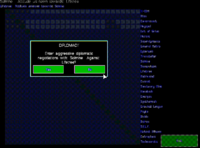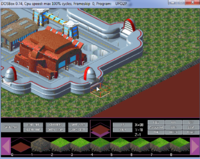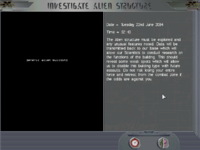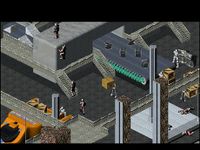Cut mechanics and features (Apocalypse)
Mythos Games said about X-Com Apocalypse
Below is an excerpt from the official Mythos Games website, stating how the game could have turned out very different!!
After completing this game I know how Francis Coppola felt after filming 'Apocalypse Now'. Just about everything that could go wrong did go wrong, and the amount of effort required to pull it into shape was immense. After three years of hard work and five different producers 'X-Com: Apocalypse' finally hit the streets. The initial game design was definitely too ambitious and too complex. The aim was to recreate in some detail the events, organisations and personalities within a futuristic megalopolis. Each corporation had a leader who could be tailed, arrested, interrogated or assassinated. Organisations could buy and sell buildings as their financial fortunes changed. X-COM agents could spy on other organisations to gain valuable information. A sophisticated diplomacy display allowed the player to instigate aggressive or defensive alliances with other organisations. There were multiple alien dimensions, generated pseudo-randomly, and the aliens gradually expanded their empire as the game progressed. The game also featured a scenario generator and multiplayer options using a hotseat turn based system or a real time LAN option. Most of these features were implemented to some degree, but were finally stripped out due to the horrendous amount of work involved in QA and debugging. We decided right at the start of the project to include an option for real time tactical combat or turn based. This decision alone caused many of the headaches for the programmers, but the final implementation of the real time combat stands up as a truly innovative system.
Found by StrategyCore, Original text
Game Storyline The year is 2084 and human civilization has undergone some fundamental changes since the last alien incursion. In an attempt to overcome Earth's problems without abandoning the planet altogether, self-contained cities called Megalopolises were erected around Earth in the year 2046. Game Play The majority of the game play takes place within the largest Megalopolis on the planet, MegaPrime. This vast city, however, is more than just a combat zone. To play the game well, players must immerse themselves in the society of Megalopolis, learning key information through interrogation of suspects and the investigation of organizations within the city. At the start of each game, the city of Megalopolis, the character skill sets and the alien universe are all uniquely generated to increase game replayability. The in-game action of X-COM Apocalypse falls into three distinct phases. The player investigates many strange, inexplicable incidents throughout the city. Inevitably these lead to conflicts with alien entities and their servants, in all kinds of locations within the city. The second phase features aliens beginning to send their larger invasion forces into direct, real-time combat with X-COM attack craft above the city. The final phase involves real-time squad level combat action sequences using an updated version of the familiar X-COM combat system. The aliens invade the city, running amok in the huge buildings and drawing players into the strange alien dimension. Players can choose either turn-based or real-time combat. Additional Game Features The X-COM agents have the same abilities as in the earlier X-COM titles with many additions including interrogation skill, perceptive ability, biochemistry, quantum physics understanding, forensics, engineering, sanity, driving skill and flying skill. The action is more lifelike, featuring SGI-rendered agents and aliens that can crawl, jump, climb, kneel, stand, run and walk.
Found by FilmBoy84, Original text
Cut mechanics and features
Diplomacy interface
Notes: Diplomacy interface that was exctracted by Skin36 and presented to Apoc community
X-Com Apocalypse Map Editor
File:CITydemo.zip Notes: You can turn Map Editor on by using hex editor and edit UFO2P.EXE and then add CITydemo to UFODATA folder. Its found by j'ordos (creator ApocD editor). Actually, this is an editor that developers used to create maps, it has full functionality and can be used to edit any map or create a new one.
Cuted Leaders, VIPs, Spies mechanics
- Each Organisation had a Organisation Leader/CEO: (Diablo and Cult of Sirius still have these sprites in the Vanilla Game Files, just disabled. In OpenApoc CoS has them enabled again and both the Cult Leader and other Leaders/VIPs can be seen on Temple raids) As Julian stated above, each organisation had their own leader or CEO that could be captured by X-COM in the battlescape. Typically, these would only be seen in the corporate HQs or Temples, but organisations could send them out on missions where their expert skills and premium weaponry could be utilised by the organisation. X-COM could capture them, or kill them, affecting their relations with the parent organisation accordingly.
- Each Organisation had regional leaders and VIPs: (Cult of Sirius still have these sprites in the Vanilla Game Files, just disabled. In OpenApoc CoS has them enabled again and both the Cult Leader and other Leaders/VIPs can be seen on Temple raids) See Above
- Each Organisation had dedicated spies: All organisations could recruit individuals with a set of skills that allowed them to operate under cover more effectively. Spies could actively assume the identity of other units as specified by the player and be sent to the buildings of other organisations to obtain information, infiltrate and influence the command structure, steal, assassinate (via battlescape "stealth" missions). The success of a spy, in all instances, was dictated by their unit stats and the player would have to be very careful in recruiting and training spies for the exact purpose X-COM intended them to be used. Spies being found or otherwise discovered in a rival organisation would severely affect relations with X-COM. Spies could also be used and exchanged in diplomacy between organisations, though this was never implemented beyond a playable "table dialogue" as far as im aware.
Cuted and planned agents skills and abilities
- All agents had an "Interrogation" skill
This skill affected how easy it was to enter interrogation/diplomacy with captured units and organisations. Similarly to the Labs/Workshop pool, the player could assign units with higher skills to the "cells" facility where they would be used to gather information.
- All agents had a "Perception" skill
This affected how much information the agent could "see" in the battle-scape or compliment "interrogation" skills in other dialogues in the cityscape. The higher an agents perception the more likely they would find forensic artefacts in missions, discover other capturable equipment in missions (a boost to the recovered kit on successful mission) and also compliment other things such as accuracy and reaction skills.
- All agents had a"Forensics" Skill
This was essential to finding all the little clues that allowed X-COM to succeed in the "One Way to Win" story arc cut from vanilla. It was used in all battlescape missions creating a chance of finding clues and artefacts that would lead to the discovery of not just one, but multiple, alien dimensions and the method to close them all down or destroy them. It could also be used to find evidence of alien infiltration of organisations and infestation of buildings as well as gain evidence for extortion and interrogation via a series of "stealth" missions. It was absolutely critical for X-COM agents to have this skill when exploring alien buildings to find their intended purpose (also missions cut from vanilla - see screen from Beta2 below) as well as the means to bring those buildings down or disable them.
- All agents had a "Sanity" Skill
This was separate to the existing psi-abilities and present on all agents. Sanity affected an agents willpower, their ability to resist interrogation by other organisations, their ability to remain safely undercover, as well as influencing how susceptible to psi-interference the agent was. Oddly, the worse an agents sanity, the harder it was for psi-abilities to affect them directly - though this was most likely a bug or points that a more detailed psi-sanity mechanism was planned but never fully realised.
- All agents had a "Driving" Skill
Vehicles were not autonomous in early Apocalypse, every agent had a driving skill that affected how fast the vehicle could be driven, how high a chance of a crash was en-route to a destination and a host of other things such as evading fire, how successful drive-by shootings would be, and so on. Every vehicle had a box to which an agent could be assigned as a "driver". The player would generally be best putting the agent with the higher driving skill there before setting off into the cityscape.
- All agents had a "Flying" Skill
Vehicles were not autonomous in early Apocalypse, every agent had a flying skill that affected how fast the vehicle could be flown, how high a chance of a crash was en-route to a destination and a host of other things such as evading fire, accuracy of the craft, ability to make special manoeuvres, drop agents stealthily into buildings, land in the battlescape (another cut feature), and so on. Every vehicle had a box to which an agent could be assigned as a "pilot". The player would generally be best putting the agent with the higher flying skill there before setting off into the cityscape.
- Agents could "Swim"
At one time Apocalypse had water, from "oceans" (as Julian Gollop put it) to small ponds, agents would have to be able to swim. How effective they were depended on other skills, but in the battlescape and stealth missions this ability was critical for traversing some obstacles. By pre-release, no oceans had appeared but some reviewers such as Al Giovetti in late 1996 (who had been granted a copy of debug) commented on the agent swimming ability:
- Agents could "Climb"
Even in the literature and screens for the vanilla release, several showed agents climbing in the battlescape. This feature was cut very late in development and was essential for Stealth missions and covert operations as well as making the standard missions easier
"Apocalypse adds many new skills, including interrogation skill, perceptive ability, biochemistry, quantum physics, forensics, engineering, sanity, driving skill, and flying skill. Another problem with the original game was the inability to move other than walk, turn, stand and run. In the new game the Silicon Graphics Incorporated rendered agents will be able to swim, crawl, jump, climb, and run in addition to the other movements."
Different mechanics
- X-COM could "capture" alien buildings in the debug version
Notes: It was unclear if this was a bug as it allowed X-COM to manufacture the aliens UFOs for example (which also provided the Dimension Shifter) or if it was a test feature.
- All Aliens and UFOs have their own "inventory" screens
Notes: because multiplayer was intended for Apocalypse and X-COM could capture and use both aliens and UFOs as above.
Source content
- https://tcrf.net/X-COM:_Apocalypse
- http://www.strategycore.co.uk/databank/games/x-com-apocalypse/concepts/
- The OpenApoc Project maintains a thread dealing with cut functions of X-COM: Apocalypse on their forums here: http://openapoc.org/threads/beta-observed-cut-functions-behaviours-items-and-units.241/
- Additionally, a detailed documentation of the cut "Spy/Interrogation/Diplomacy" features can be found here: http://openapoc.org/threads/beta-of-spies-interrogation-forensics-extortion-agent-skills-vips.278/






